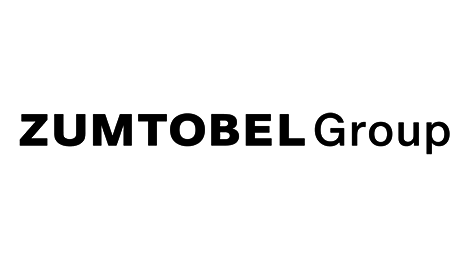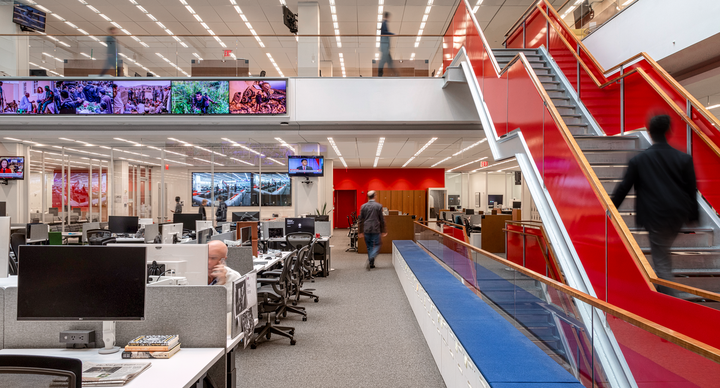Zumtobel – Custom solution for the transition to LED lighting at the offices of the New York Times
Dornbirn, 16 January 2024 – The New York Times Building opened in 2007 and offers a mix of office and retail space over 52 floors, with its open-plan rooms and floor-to-ceiling views perfect for the busy main newsroom and offices of the building’s main tenant, the New York Times.
When the building was originally fitted out in 2007, design firm Gensler worked with Attila Uysal and Susan Brady Lighting Design Studio to develop Zumtobel’s shadow- and glare-free lighting system to ensure it could be fully integrated with other building systems in order to maximise energy performance.
LED technology for the future
In the early 2020s, the New York Times building management team wanted to take advantage of advances in LED lighting technology, as they saw this as an opportunity to make additional energy savings. The question was whether a retrofit solution could be found that improved appearance, flexibility and lighting quality without requiring new light fixtures and controls or the associated high costs.
“The New York Times management team knew the fluorescent tube technology was obsolete,” says Attila Uysal of Lumen Architecture. “A retrofit solution had to be compatible with the existing luminaires and the digital control system. It was a complex retrofit involving lots of detail.”
The New York Times building management team explored a number of retrofitting solutions, but the initial options were not compatible with the original Zumtobel luminaires. The New York Times team therefore brought in Attila Uysal, who had been involved as a lighting advisor when the building was originally fitted out and now works at Lumen Architecture in New York City. Uysal suggested an affordable custom refurbishment kit from Zumtobel.
The Zumtobel team demonstrated how the fluorescent lamps and lamp sockets could be disassembled and the kit installed, for a much more uniform and visually appealing integration of the luminaire into the ceiling. It’s like a completely new lighting solution.
— Attila Uysal, Architect at Lumen Architecture



The LED retrofit allowed the New York Times to retain 80 to 90 per cent of the original aluminium and steel fittings, helping both the New York Times and Zumtobel to meet their sustainability goals.
Tried-and-tested retrofit optics
Zumtobel had already developed LED retrofit optics that were fully compatible with the original T5 luminaires. This optimised LED solution met the New York Times’ energy efficiency requirements and made an overall improvement to the visual environment. The Zumtobel refurbishment kit ensures the luminaire itself has a consistently bright appearance and also extends the batwing distribution compared to that of the original T5 configuration. The entire space behind the metal grid is uniformly illuminated, eliminating the shadows previously created by the fluorescent tubes and their lamp sockets – not only improving the appearance of the room but also offering enhanced visual comfort for the New York Times employees.
Sustainable and cost-efficient
Thanks to the LED retrofit, 80 to 90 per cent of the original aluminium and steel fittings could be retained, helping both the New York Times and Zumtobel to meet their sustainability goals. The retrofit also cost significantly less than a completely new lighting solution. Another benefit of the Zumtobel refurbishment kit was its speed of installation: a kit could be installed in just 20 minutes, which minimised disruption to work in the newsroom and offices.
“The refurbishment kit for the New York Times Building was the perfect choice because Zumtobel knew exactly how the original luminaires were designed. The Zumtobel team demonstrated how the fluorescent lamps and lamp sockets could be disassembled and the kit installed, for a much more uniform and visually appealing integration of the luminaire into the ceiling. It’s like a completely new lighting solution,” concludes Attila Uysal.
SourceZUMTOBEL Group AG
EMR Analysis
More information on Zumtobel: See the full profile on EMR Executive Services
More information on Alfred Felder (Chief Executive Officer, Zumtobel Group): See the full profile on EMR Executive Services
More information on The New York Times: https://www.nytimes.com/ + The New York Times is dedicated to helping people understand the world through on-the-ground, expert and deeply reported independent journalism.
The New York Times Company is a trusted source of quality, independent journalism whose mission is to seek the truth and help people understand the world.
With more than 10 million subscribers across a diverse array of print and digital products — from news to cooking to games to sports — The Times has evolved from a local and regional news leader into a diversified media company with curious readers, listeners and viewers around the globe.
- 2,600+as of December 31, 2022
- 55Languages spoken by staff
- 9+ milTotal subscribers
- 235Countries with our subscribers as of Q3 2022
More information on Joseph Kahn (Executive Editor, The New York Times): https://www.nytco.com/company/people/ + https://www.linkedin.com/in/joe-kahn-85411636/
More information on Meredith Kopit Levien (President and Chief Executive Officer, The New York Times): https://www.nytco.com/company/people/ + https://www.linkedin.com/in/mlevien/
More information on Gensler: https://www.gensler.com/ + Gensler is a global architecture, design, and planning firm with 53 locations and 6,000+ professionals networked across the Americas, Europe, Greater China, Asia Pacific, and the Middle East. Founded in 1965, the firm works globally with more than 3,500 clients across 33 practice areas spanning the work, lifestyle, cities, and health sectors. We are guided by our mission to create a better world through the power of design and believe the source of our strength is our people.
More information on Diane Hoskins (Co-Chief Executive Officer, Gensler): https://www.gensler.com/people/co-ceos + https://www.linkedin.com/in/dianehoskins/
More information on Andy Cohen (Co-Chief Executive Officer, Gensler): https://www.gensler.com/people/co-ceos + https://www.linkedin.com/in/andy-cohen-faia/
More information on Attila Uysal (Lighting Designer and Teacher, Lumen Architecture PLLC): https://lumenarch.com/about/attila-uysal + https://www.linkedin.com/in/attila-uysal-28b634b/
More information on Susan Brady (Principal, SBLD): https://www.sbldstudio.com/about/team/ + https://www.linkedin.com/in/susan-brady-8511b18/
EMR Additional Notes:
- LED:
- LED stands for light emitting diode. LED lighting products produce light up to 90% more efficiently than incandescent light bulbs. How do they work? An electrical current passes through a microchip, which illuminates the tiny light sources we call LEDs and the result is visible light.
- A light-emitting diode is a semiconductor light source that emits light when current flows through it. Electrons in the semiconductor recombine with electron holes, releasing energy in the form of photons.
- LED vs. Halogen:
- Halogen bulbs, while lasting longer than incandescent bulbs, only last up to 2,000 hours. In contrast, LED bulbs can last up to 25,000 hours, and LED tubes are rated for up to 50,000 hours. LED bulbs can use as much as 80% percent less energy than halogen bulbs.
- There’s obviously a clear winner when it comes to LED vs halogen lighting. LED lights are more energy-efficient, have a longer lifespan, and offer more choices in color temperature. They do cost a little more, but their extremely long lifespan easily offsets the higher upfront cost.
- microLED:
- Compared to widespread LCD technology, microLED displays offer better contrast, response times, and energy efficiency. They are also capable of high speed modulation, and have been proposed for chip-to-chip interconnect applications.
- MicroLED prototype displays have been shown to offer up to 10 times more brightness than the best OLED panel while being significantly more power efficient, making them an exciting new technology in the world of displays.
- OLED (Organic Light-Emitting Diode):
- This refers to the panel that’s used inside an OLED TV – or any other kind of OLED screen. So it’s the OLED panel makes OLED TVs stand out in comparison to other types of panels. You’ll also find CRT (cathode ray tube), LED (light-emitting diode), LCD (liquid crystal display), or QLED (quantum dot).
- LED LCD screens use a backlight to illuminate their pixels, while OLED’s pixels produce their own light. You might hear OLED’s pixels called ‘self-emissive’, while LCD tech is ‘transmissive’. The light of an OLED display can be controlled on a pixel-by-pixel basis.
- OLED TVs should offer better overall eye comfort than QLED and any other LCD-based screen, because OLED produces significantly less blue light than LED-backlit QLED TVs.
- T5 – T8 Fluorescent Lamps:
- The “T” designation in fluorescent lamp nomenclature stands for tubular — the shape of the lamp. The number immediately following the T gives the diameter of the lamp in eighths of an inch. A T8 lamp (on the right in the figure below) is eight-eighths of an inch, or one inch (2.54 cm), in diameter.



